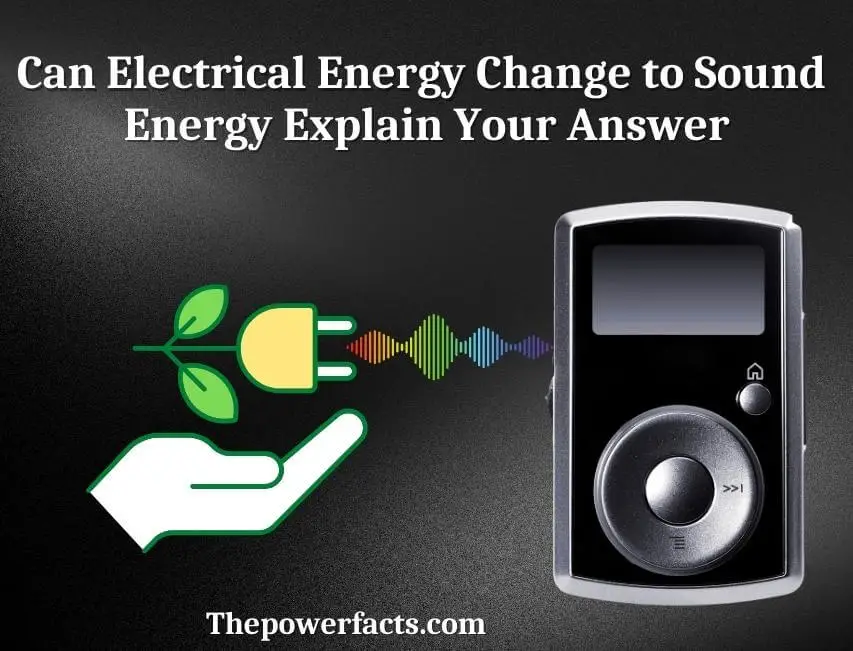Published on: February 25, 2023
Written by Jonas Frank / Fact-checked by Nova Scarlett
Yes, electrical energy can be converted to sound energy. When an electrical current is applied to a speaker, the speaker vibrates and produces sound waves. The frequency of the sound waves depends on the frequency of the electrical current.
Can Electrical Energy Change to Sound Energy Explain Your Answer. We know that sound is a type of energy that travels through the air, or any other medium, as a vibration of pressure waves. But what about its relationship to electricity?

Can electrical energy change to sound energy? Here’s how it works: when an object vibrates, it sets off vibrations in the air particles around it. These vibrations travel through the air until they reach our ears, where they cause our eardrums to vibrate.
This vibration is then converted into nerve impulses that are sent to our brain, which interprets them as sound. So, in order for sound to be produced, there needs to be something that can vibrate (like a drumhead) and something for the vibrations to travel through (like air). Electricity can create vibrations in objects – like when you plug your guitar into an amplifier and strum the strings.
The amplified signal causes the speaker cone inside the amplifier to vibrate, which then sets off vibrations in the air around it. These vibrations eventually reach your ears and are interpreted as sound. Therefore, yes – electrical energy can be converted into sound energy!
What Changes Electrical Energy into Sound Energy?
When you clap your hands, strike a drum, or pluck a guitar string, you’re making sound by converting energy from one form to another. Your muscles supply the energy to your hand, which transfers it to the air as sound. In an electric guitar, an amplifier does the work of your muscles—and then some.
An electric guitar has strings that vibrate when plucked. These vibrations are converted into electrical currents by pickups located under the strings. The current flows through a cable to the amplifier, where it’s used to drive speakers that create sound waves in the air.
The volume and tone of an electric guitar can be controlled in several ways. The most common is by adjusting the controls on the amplifier. But guitars also have volume and tone controls built into them—usually on the body near the pickups—that let you adjust the level of the signal going to the amplifier without affecting other settings.
How is Electrical Energy Converted to Sound Energy by the Speaker?
A speaker is a transducer that converts electrical energy into sound waves. When an electrical signal is applied to the voice coil, a magnetic field is generated. This magnetic field interacts with the permanent magnet and causes the cone of the speaker to move.
The movement of the cone produces sound waves in the air. The quality of the sound produced by a speaker depends on several factors, including the size of the cone, the material used for the cone, the type of suspension, and the type of enclosure.
How Does Sound Energy Get Changed Into Electrical Energy?
When light energy hits an object, it causes the particles in that object to vibrate. This vibration creates sound waves. The sound waves travel through the air and eventually reach our ears, where they cause our eardrums to vibrate.
This vibration is converted into electrical energy by the auditory nerve, which sends signals to our brain that we interpret as sound. In order for this process to happen, several things must occur: first, the object must be able to reflect or emit light; second, there must be a medium (such as air) for the sound waves to travel through; and third, there must be a mechanism (such as our ears) for converting the vibrations into electrical signals. There are many everyday examples of objects that reflect or emit light and create sound waves: musical instruments, voices, and even some types of animals (like crickets).
When these objects are working properly, we can hear their sounds loud and clear. But what about objects that don’t produce any noise themselves? Can they still create sound waves?
The answer is yes! Any time two objects collide with each other, they create vibrations that travel through the air as sound waves. For example, when you clap your hands together or stomp your feet on the ground, you’re actually creating quite a bit of noise!
Examples of Chemical Energy to Heat, Light, And Sound Energy
Chemical energy is the type of energy that is stored in the bonds between atoms and molecules. When these bonds are broken, energy is released in the form of heat, light, or sound. For example, when you burn wood in a fire, the chemical energy in the wood’s molecules is converted into heat and light energy.
Similarly, when you detonate a bomb, the chemical energy in the explosives is converted into heat, light, and sound energy. In both cases, the amount of energy released depends on how much fuel (wood or explosives) is available. The more fuel there is the more energy that can be released.
Chemical Energy Being Converted to Motion Energy
We all know that when we put gasoline in our car and turn the key, the engine starts and we can go. But how does this happen? It’s all thanks to chemical energy being converted to motion energy!
When gasoline is burned in the engine, it creates a lot of heat. This heat is then used to create motion by expanding gases within the cylinders. As these gases expand, they push against the pistons and cause them to move.
This movement turns the crankshaft, which in turn powers the wheels of your car!
So next time you’re out for a drive, remember that it’s not just the gasoline powering your car – it’s also the amazing process of chemical energy being converted to motion energy!
Example of Sound Energy
Sound is a type of energy that travels through the air, or any other medium, as a vibration of pressure waves. The source of the sound produces these waves by vibrating its medium (air, water, solid objects, etc.), which then causes the surrounding medium to vibrate. Our ears detect these vibrations and translate them into the sensation of sound.
The speed of sound is determined by the properties of the medium through which it is traveling. For example, sound travels faster through denser materials like water than it does through less dense materials like air. The speed of sound also depends on temperature; in general, sound travels faster in warmer environments.
There are two main types of sounds: natural and artificial. Natural sounds are those produced by animals, humans, and nature (e.g., thunder, raindrops). Artificial sounds are those made by man-made objects or devices (e.g., alarms, car horns).
Sound energy is measured in decibels (dB). The higher the decibel level, the more intense the noise. Exposure to high levels of noise can cause hearing loss over time.
7 Uses of Sound Energy
1. Sound energy can be used to create heat.
2. Sound energy can be used to create light.
3. Sound energy can be used to create electricity.
4. Sound energy can be used to produce motion.
5. Sound energy can be used for communication purposes.
6. Sound energy can be harnessed to power musical instruments.
7. Sound waves can help clean surfaces and objects. 8 Sound waves are often used in medical therapies.
How is Electrical Energy Converted Into Sound Energy?
Did you know that your brain is responsible for converting electrical energy into sound energy? That’s right – without your brain, you wouldn’t be able to hear a thing! So how does this process work?
Well, it all starts with the ear. Sound waves enter the ear and cause the eardrum to vibrate. These vibrations are then passed on to three tiny bones in the middle ear, which amplifies the sound and sends it along to the cochlea.
The cochlea is a snail-shaped structure filled with fluid. Inside the cochlea are thousands of tiny hair cells that are responsible for converting vibration into electrical signals. These electrical signals are then sent to the auditory nerve, which carries them to the brain where they are finally converted into sound.
Pretty amazing, right? So next time you hear a noise, take a moment to think about all of the complex processes that had to occur in order for you to hear it!

How Are Electrical Energy and Chemical Energy Related?
When it comes to energy, there are two main types: electrical and chemical. Electrical energy is the kind of energy that powers our electronic devices, while chemical energy is what fuels our bodies and helps us to grow and survive. The difference between these two types of energy is that electrical energy is created by the movement of electrons, while chemical energy is created by the interaction of atoms and molecules.
Electrical energy is always converted into other forms of energy (like heat or light), while chemical energy can be stored in bonds between atoms. So how does this all work? Let’s start with a simple example: a battery.
A battery has two terminals, a positive and a negative. The positive terminal has more electrons than the negative terminal, so when you connect the two terminals with a conductor (like a wire), the electrons flow from the positive to the negative terminal. This flow of electrons creates an electric current, which powers your electronic devices.
Now let’s look at an example of chemical Energy storage: photosynthesis. Plants take in sunlight and convert it into glucose (a type of sugar). Glucose is then used by plants to create ATP (adenosine triphosphate), which stores chemical Energy in its bonds.
When we eat plants or plant-based products (like grains or vegetables), we’re essentially eating stored solar Energy!
Here are the Sources of Sound Energy
There are many sources of sound energy. Some common sources include
1. Human voices – when we speak, our vocal cords vibrate and produce sound waves.
2. Musical instruments – when we play an instrument, the strings or reeds vibrate and produce sound waves.
3. Sound recordings – these can be either digital or analog recordings of sounds that have been made in the past.
4. Ambient noise – this is the background noise that we hear all around us, such as the sound of traffic or birds chirping.
Last Remarks
Yes, electrical energy can be converted to sound energy. When electricity flows through a conductor, it creates a magnetic field. This magnetic field can interact with another object to create sound.
For example, when an electrical current is passed through a coil of wire (such as in a loudspeaker), it creates a magnetic field that interacts with the permanent magnet in the speaker. This interaction causes the speaker cone to vibrate, which produces sound waves.
